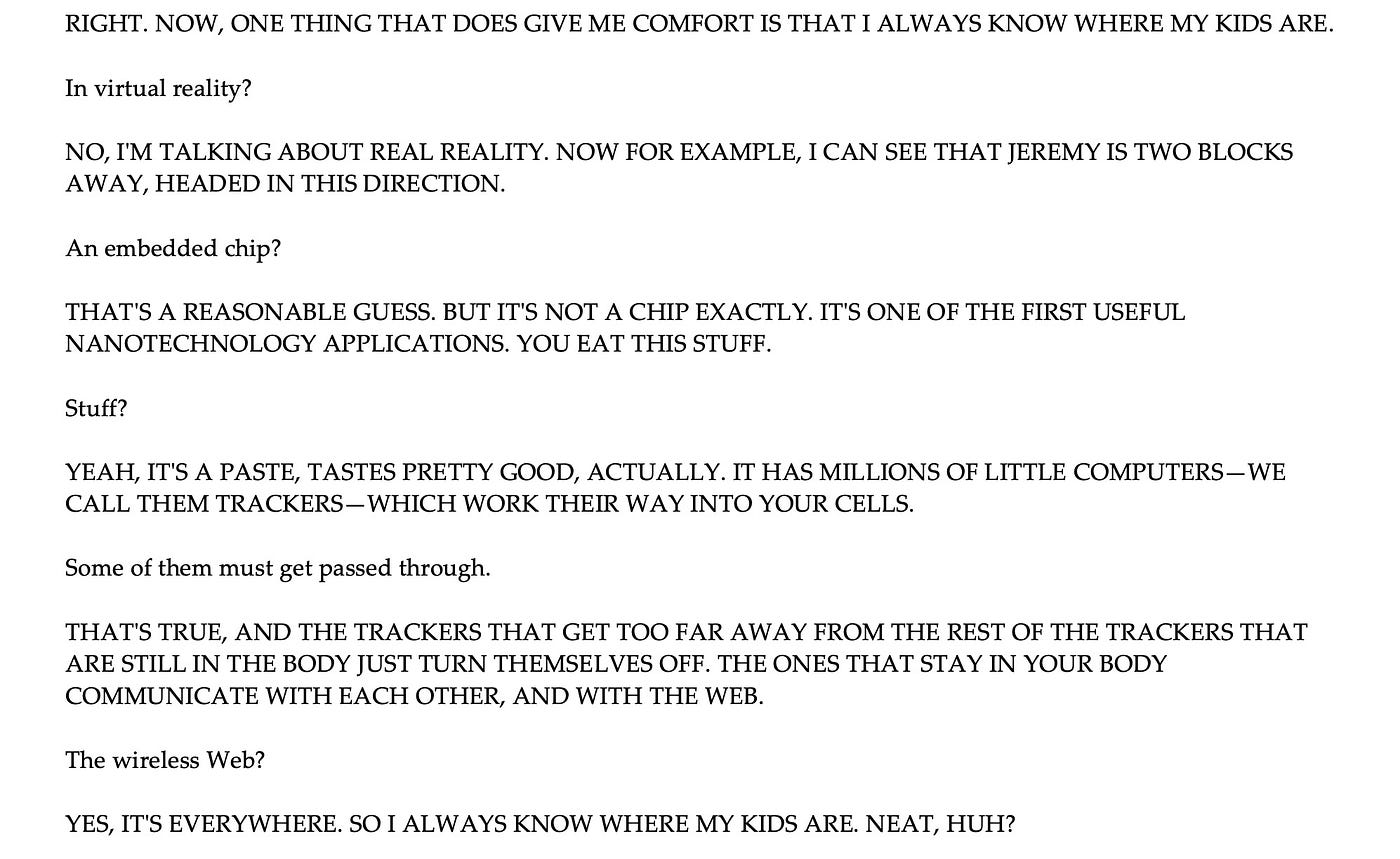How Futurists Got The Future All Wrong

In 1999, Ray Kurzweil published The Age Of Spiritual Machines. As a teenager, the book had a great influence on me. I actually believed in what he called ‘the singularity’ and I was looking forward to it. This singularity was a point of exponential growth that would be awesome. Evolution of machines would proceed forever, because “information and knowledge are not limited by the availability of material resources.” I was lucky enough to be along for the ride.
Now I’ve been on the ride for 24 years and, holy shit, I want to get off. Exponential growth turns out to be planetary cancer, not a panacea. Kurzweil never discussed energy use, resource use, pollution, and environmental destruction, and those turn out to be pretty important. Kurzweil blithely said, “Most Exponential Trends Hit a Wall… but Not This One,” in complete ignorance of the fact that we live in a connected world. His conception of AI is, in hindsight, just a dumb buzzword attached to a planet-destroying buzz saw.
Ignoring the fact that the entire premise of the book is wrong, its specific predictions are also wrong. Kurzweil predicted that we’d be having convincing virtual sex, eating and shitting nanobots, and be spending most of our time and money in AR/VR. Not in the distant future but quite specifically in 2019. Which, as you may have noticed, has come and gone. And also sucked. Even on his own wildly ignorant terms, Kurzweil was completely wrong.
Let’s go through his predictions, one by one.
The Predictions, One By One

1. Your computer will be as smart as you
A $1,000 computing device (in 1999 dollars) is now approximately equal to the computational ability of the human brain.
I use a 2020 MacBook Air, costing a bit under $1,000 adjusted dollars, and it is not approximately equal to the human brain. This is a strange prediction because Kurzweil says $1,000 worth in the timeline and $4,000 worth in the text but, either way, it’s wrong.
As a measure (to compare brains and computers) Kurzweil uses calculations per second. He said the amount of FLOPS (floating-point operations per second) of the human brain was 2×10¹⁶. His prediction would be that a consumer computer exceeds that processing power by 2019. A) This is comparing apples and oranges and B) it hasn’t happened.
My M1 chip is technically capable of 10.4 TFLOPs, which is about 10¹³. This is off by a factor of 2,000. Even if we’re generous and use the 2023 The M2 Ultra Chip (which sells for about $4,000+ current dollars), it’s still way off. That does 27.2 TFLOPS (about 3×10¹³), which is still not even in the right ballpark. And the ballpark itself is the wrong sport, because intelligence isn’t doing math over and over. Both conceptually and practically, Kurzweil was just,
WRONG.

2. Computation will be invisible
Computers are now largely invisible and are embedded everywhere — in walls, tables, chairs, desks, clothing, jewelry, and bodies.
Besides watches, computers don’t appear any of these places at all. And they’re certainly not invisible. By 2019, Kurzweil imagined ubiquitous augmented reality and he based a lot of his further predictions on this assumption. But this assumption is false.
Kurzweil said that, by 2019,
People routinely use three‐dimensional displays built into their glasses, or contact lenses. These ʺdirect eyeʺ displays create highly realistic, virtual visual environments overlaying the ʺrealʺ environment. This display technology projects images directly onto the human retina, exceeds the resolution of human vision, and is widely used regardless of visual impairment.
This technology just doesn’t exist. Google Glass was a failed prototype years ago and it never caught on. The Apple Vision Pro (which we’ll discuss) is an expensive curiosity that walk around with. All we really have is a bunch of different screen sizes that you can wear on a wrist or hang on a wall, but they’re not invisible. The ubiquitous computing that Kurzweil bases almost all of his predictions on doesn’t exist, which is why almost all of his predictions are…
WRONG

3. Seamless Virtual Reality
Three‐dimensional virtual reality displays, embedded in glasses and contact lenses, as well as auditory ʺlenses,ʺ are used routinely as primary interfaces for communication with other persons, computers, the Web, and virtual reality.
Based on the assumption of ubiquitous, effectively magical computational and visualization power, Kurzweil predicts that augmented and virtual reality will be the dominant Information Communication Technology of the future, ie 2019. Having lived through 2019, I can say definitely not. AR and VR headsets exists but they A) mostly suck and B) are not popular at all.
The Apple Vision Pro, which came out in 2023, exists. It lets you watch a movie by yourself on a ‘virtually’ big screen, using two OLED screens in front of your eyes. This headset costs $2,000 (in 1999 dollars) and is not popular at all. Projected sales have been revised down from 1 million to 250,000 to 150,000. Not the sort of exponential growth Kurzweil was talking about.
Even this advanced device is not glasses (unless you call something that weighs nearly 1 kg, comes with a battery, and dies after two hours glasses) and it is nowhere near fitting inside a context lens. AR/VR technology is nowhere near being a primary interface, let alone a secondary or even tertiary one. The vast majority of people have never used this technology at all, and most people that do don’t find it especially compelling. On this point, Kurzweil was again
WRONG

4. Gestures and natural language
Most interaction with computing is through gestures and two‐way natural‐language spoken communication.
Building on the assumption of AR/VR, Kurzweil says that most people will communicate with their computers ‘naturally’, using gestures and natural language. Given that most people don’t use AR/VR, this is necessarily false.
People do use some gestures on smartphones, but mostly we are pushing buttons and using (software) keyboards. These are all functions you could do with a physical keyboard and mouse, there’s nothing especially novel here besides a touchscreen. Siri and Alexa and voice assistants exist, but I wouldn’t call talking to them ‘natural’. Kurzweil said that in 2019 “People communicate with computers the same way they would communicate with a human assistant, both verbally and through visual expression,” and it really doesn’t work like that. ChatGPT brings you close to natural conversation, albeit with a pathological liar who can’t remember anything beyond 2021. So not the most reliable assistant, and still not used that way.
None of this stuff has come to pass, certainly not by 2019.
WRONG

5. Nanoengineered machines
Nanoengineered machines are beginning to be applied to manufacturing and process‐control applications.
In a technology he doesn’t really distinguish from magic, Kurzweil predicts that by 2019, “Autonomous nanoengineered machines can control their own mobility and include significant computational engines. These microscopic machines are beginning to be applied to commercial applications, particularly in manufacturing and process control, but are not yet in the mainstream.”
What does this mean? In a conversation Kurzweil has with a FUTURE PERSON, he goes into it:

This seems like hideous overkill for something we could accomplish with GPS technology since the 1980s. Which is what we do now, without feeding a million computers to our children. Nanoengineering is still very much in research stages, but nanoengineering like this isn’t even thought of.
WRONG

6. Tactile Virtual Reality
High‐resolution, three‐dimensional visual and auditory virtual reality and realistic all‐encompassing tactile environments enable people to do virtually anything with anybody, regardless of physical proximity.
So, virtual sex. Kurzweil says that by 2019 “users feel as if they are physically near the other person. The resolution equals or exceeds optimal human visual acuity.” Kurzweil goes further to say that we’ll have tactile and olfactory technology by 2019. He says,
“The all‐enveloping tactile environment is now widely available and fully convincing. Its resolution equals or exceeds that of human touch and can simulate (and stimulate) all of the facets of the tactile sense, including the sensing of pressure, temperature, textures, and moistness.”
This is describing full-on virtual sex, which simply isn’t happening. People are definitely FaceTiming their asses and masturbating, but this is nowhere near being able to touch another person. That just happened.
WRONG

7. No more teachers, no more books
Paper books or documents are rarely used and most learning is conducted through intelligent, simulated software‐based teachers.
Paper books and documents are still commonly used. According to a 2021 Pew survey (in the US), “Print books remain the most popular format for reading, with 65% of adults saying that they have read a print book in the past year.” Electronic documents exist for many functions, but people still use passports and fill out forms.
Regarding learning, intelligent, simulated teachers don’t exist. You can teach yourself via DuoLingo or by watching videos, but this is not a teacher. It’s not really much different than old mail order classes or lessons on VHS.
Kurzweil also says that “Most adult human workers spend the majority of their time acquiring new skills and knowledge,” which is not what’s going on. Essential workers are still doing repetitive, physical work and ‘knowledge’ workers are largely bullshitting. In the US, workers spend about 50–70 hours on training, per year. Most adults spend very little time educating themselves, unless it’s on their own time and dime.
WRONG

8. The deaf shall hear and the blind shall see
Blind persons routinely use eyeglass‐mounted reading‐navigation systems. Deaf persons read what other people are saying through their lens displays. Paraplegic and some quadriplegic persons routinely walk and climb stairs through a combination of computer‐controlled nerve stimulation and exoskeletal robotic devices.
Unfortunately, no. For the blind, Kurzweil presupposes “new computer‐controlled optical‐imaging technology using quantum‐based diffraction devices [which] has replaced most lenses with tiny devices that can detect light waves from any angle. These pinhead‐sized cameras are everywhere.” This of course doesn’t exist, so the product he envisions for blind people doesn’t exist either. What he imagines is that:
Blind persons routinely use eyeglass‐mounted reading‐navigation systems, which incorporate the new, digitally controlled, high‐resolution optical sensors. These systems can read text in the real world, although since most print is now electronic, print‐to‐speech reading is less of a requirement. The navigation function of these systems, which emerged about ten years ago, is now perfected. These automated reading‐navigation assistants communicate to blind users through both speech and tactile indicators. These systems are also widely used by sighted persons since they provide a high‐resolution interpretation of the visual world.
This technology just doesn’t exist, even in prototype form. What he’s talking about is perfect, invisible robot vision which understands what it’s seeing in natural language and can guide a blind person. This is nowhere near production, let alone ‘widely used’. Blind people still use dogs.
In terms of the lame walking, people are still using walkers and canes, and even the most expensive technology struggles with stairs. Exoskeletons exist in prototype form, but the main interest seems to using them killing and disabling people through military use.
This would be a nice use of technology but we’re sadly nowhere near this level of augmented ability for the disabled.
WRONG

9. Self-driving and robot lovers
The vast majority of transactions include a simulated person. Automated driving systems are now installed in most roads. People are beginning to have relationships with automated personalities and use them as companions, teachers, caretakers, and lovers.
The vast majority of transactions in 2019 did not involve a simulated person.
Kurzweil predicted “the cybernetic chauffeur… by the end of the 1990s with implementation on major highways feasible during the first decade of the twenty‐first century.” This did not happen. Elon Musk has been promising self-driving cars since 2013, calling it a ‘solved problem’ in 2023. It’s still not solved, nor is it a real problem. Efficient transport is much better solved by a bus or metro, technologies that have been around since the 1800s. Self-driving cars are an expensive vanity project which is still being tested in the 2020s, and they’re still driving themselves into traffic and running over homeless people.
Regarding robots that you can have meaningful relationships with, that just isn’t happening at all.
WRONG

10. Virtual art
Virtual artists, with their own reputations, are emerging in all of the arts.
While 2023 has been a banner year for virtual art, that is still humans putting prompts into a machine. Kurzweil is talking about virtual artists, with their own reputations, and that simply isn’t happening.
Kurzweil also says:
The type of artistic and entertainment product in greatest demand (as measured by revenue generated) continues to be virtual‐experience software, which ranges from simulations of ʺrealʺ experiences to abstract environments with little or no corollary in the physical world.
Again, Kurzweil is presupposing a virtual world that doesn’t exist, so the revenues don’t either. Modern VR is a place to incinerate money, it doesn’t make it.
The highest earning artists are still old farts like Genesis and the Rolling Stones, selling their music rights or touring. Abba has made good money performing concerts with avatars, but this is a novelty tied to a specific location. There is very little VR specific content at all. It’s a rounding error in terms of entertainment revenue, not what’s in greatest demand. People still want to go to a show.
WRONG

11. Passing the Turing Test
There are widespread reports of computers passing the Turing Test, although these tests do not meet the criteria established by knowledgeable observers.
I’ll give Kurzweil this one. As of 2019 no, but as of 2023 I think ChatGPT and its ilk can pass the Turing Test (convincing a human that it’s human). Many business emails are written with ChatGPT with none the wiser.
There is surprisingly little debate about bots passing the Turing Test, because it doesn’t seem to matter that much. But you have to give Kurzweil this one, IMHO.
RIGHT
The Results
If you’re keeping track, that’s 10/11, and that’s just the highlights. Kurzweil made a lot of specific predictions which are completely off. He said that by 2019, “there is sufficient prosperity to provide basic necessities (secure housing and food, among others) without significant strain to the economy.” I suppose there is sufficient prosperity, but the rich ain’t sharing. My people are hungry and yours are homeless.
In terms of warfare he said, “The primary threat to security comes from small groups combining human and machine intelligence using unbreakable encrypted communication. These include (1) disruptions to public information channels using software viruses, and (2) bioengineered disease agents. Most flying weapons are tiny — some as small as insects with microscopic flying weapons being researched.” I don’t know what this means. We’re having pitched tank battles in 2023.
Ray said the expected human lifespan would double to over 100, while it’s actually declining in America. He predicted flying cars, saying “Efficient personal flying vehicles using microflaps; have been demonstrated and are primarily computer controlled. There are very few transportation accidents.” We still don’t have flying cars. We never will. It’s swill.
Are In
I respect Kurzweil, though I disagree with him now. He had the balls to make predications and be falsifiable. And he’s provable false now. The wildest imagination of the futurists hasn’t come true, and our worst nightmare has come to life. And they didn’t see it coming. The thrills Kurzweil predicted for 2019 haven’t happened. The threats he didn’t predict have come to life. By all accounts this is an epic fail. A complete failure of imagination.
To me, as a 41 year old, the failures of Kurzweil are just this. He started from half-baked theory and got inedible results. Kurzweil said “Evolutionʹs grandest creation — human intelligence — is providing the means for the next stage of evolution, which is technology… the resources of evolution, order and chaos, are unbounded. I stress this point because it is crucial to understanding the evolutionary—and revolutionary—nature of computer technology.” This is simply arrogance. We are way less cool than dinosaurs, and even technical evolution require physical resources. Technology is not merely restricted by concepts, like ‘chaos’, and ‘order’. It needs silicon, and electricity, and water-cooling.
Kurzweil said, “Information and knowledge are not limited by the availability of material resources,” and this is just false. This technology uses rare earth metals and energy and water in huge amounts. And it chews up the Earth in huge chunks. Of course, technology is limited by available resources, it’s not fucking magical. Kurzweil thought differently, and this was dumb, but at least he had the courage to make detailed predictions.
Now that it’s 2019 we can check his predictions and, boy, were they off. 2019 was a singlar year, in that it was singulary shit and the shit has not subsided till now. 2019 was the year of COVID, not some artificial consciousness. It was the year of the natural world sending us the first of many plagues, and saying ‘wake the fuck up’. This isn’t the age of spiritual machines. It’s the age of natural consequences. The futurists missed this in their predictions of the future. The future is fucked.